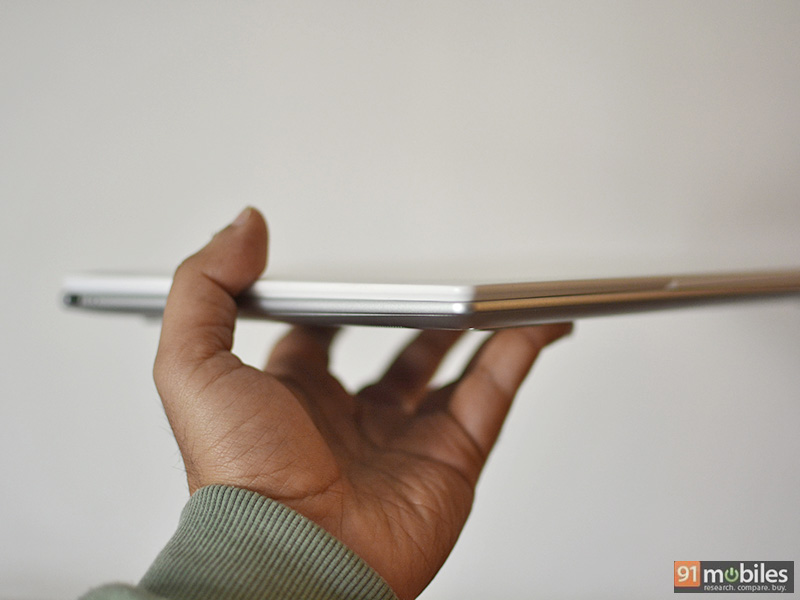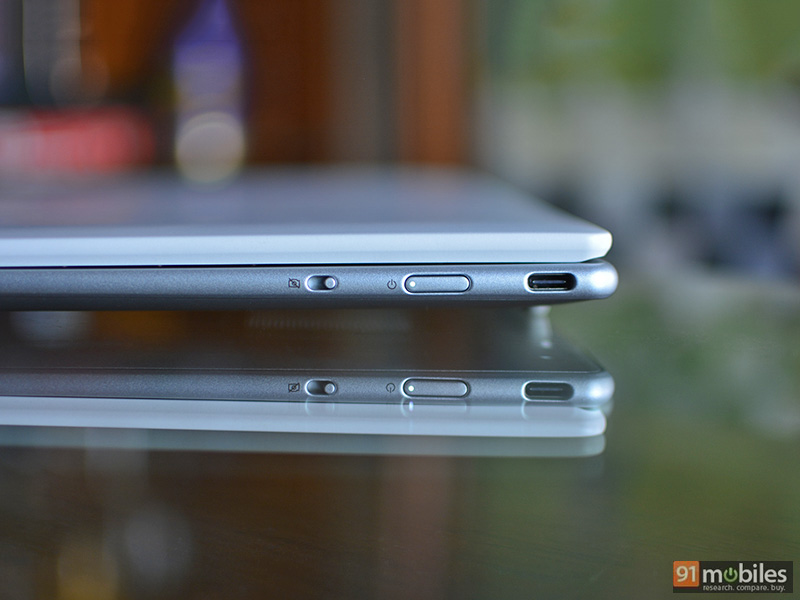Whenever someone talks or asks me what’s the best 13-inch laptop, I instinctively think about the Dell XPS 13. It has been the king of premium 13-inch Windows ultrabooks and still remains one of the best in its class. But if you are looking for some variety, there are many options to choose from. One such product is the Lenovo Yoga Slim 7i Carbon. The latest 7th-generation model is powered by Intel’s 12th-gen Alder Lake-P processors (Core i5 and Core i7) and features a sharp 13.3-inch 2.5K resolution display with a 16:10 aspect ratio and 90Hz refresh rate.

The real highlight though, is the design. The Yoga Slim 7i Carbon borrows the lightweight materials from Lenovo’s ThinkPad Carbon series making it one of the lightest 13-inch ultrabooks, and a tough competition for the XPS 13. But is it good enough? Read on for more.
Design and build
The Yoga Slim 7i Carbon can easily be mistaken for an inexpensive plastic Chromebook, especially the Moon White colour variant. However, this is a premium machine and you can feel that once you get your hands on it. Also available in Cloud Grey and Storm Grey colours, the construction on the laptop is rigid and sturdy thanks to the carbon fibre lid and aerospace-grade magnesium alloy chassis. There is hardly any noticeable flex and overall the finish of the laptop is immaculate.


The combination of the above materials also makes the Yoga Slim 7i Carbon one of the lightest 13-inch laptops, as it boasts a weight of just under 1kg and a thickness of 14.8mm. It also has a small footprint, not much larger than its 13.3-inch display, making it quite portable and easy to carry around. The display has a matte finish with a screen-to-body ratio of 83 percent and narrow bezels. The top bezel also makes space for the 720p webcam that includes an IR sensor for Windows Hello face recognition.

Lenovo has also made sure that the design doesn’t have any imperfections and I really appreciate the rounded edges that add a touch of finesse. The hinge feels tough and opens smoothly with just one hand using the raised lip in the middle. There is also little to no screen wobble which is great when you are using the laptop on your lap or if you are someone who types vigorously.


Now one of the biggest issues with thin and light ultraportable laptops is that they tend to skimp on I/O for obvious reasons, and sadly, it is the same case here. There are only two ports on this laptop – a USB Type-C Thunderbolt 4 port and a USB Type-C 3.2 Gen 2 port on the opposite side. Lenovo does bundle a USB hub in the box that includes an HDMI port, a 3.5mm audio jack, a USB Type-A port and a VGA port. Essentially you cannot travel with this laptop without carrying the hub. Apart from the I/O there is also the power button and a webcam shutter toggle switch on the right side.

Display
The Yoga Slim 7i Carbon comes with an impressive 13.3-inch display. It uses an IPS panel with a 2.5K or 2,560 x 1,600-pixel resolution with 90Hz refresh rate, 400-nits brightness, and 16:10 aspect ratio. It is also calibrated to cover 100 percent of the sRGB colour space and Delta Ε<1 alongside TÜV Rheinland Low Blue Light certification and support for Dolby Video. The screen has a matte finish which also helps in reducing glare and reflections, and there is an optional touch screen variant. The hinge allows the screen to go back all the way up to 180° so you can lay it flat on your desk.

The high pixel density makes for sharp visuals and overall the colour accuracy on the display is quite pleasing. I enjoyed watching video content on Netflix and YouTube, and while the 90Hz refresh rate wasn’t a huge advantage, it did make the Windows UI experience smoother. Brightness is fairly good for indoor and outdoor usage and notably, the Windows 11 auto brightness feature is enabled by default to save battery life. Additionally, Lenovo’s built-in Vantage software allows you to tweak and adjust the Eye Care Mode which is a blue light filter as well as colour temperature.
Keyboard and trackpad
The keyboard experience is decent. The keys are large with proper spacing between them while the keyboard spans across the left and right edges. The short key travel distance of 1mm might be a sore thumb for some users, but I honestly didn’t take a lot of time to get used to it. As with most Lenovo laptops, there are some Function key shortcuts to switch between performance modes (Fn + Q) and different brightness levels of the keyboard backlight (Fn + Spacebar). The Function key row on top offers a nice range of secondary controls and settings and to top it off the built-in proximity sensor lights up the keyboard as soon as you approach it.

As for the trackpad, it is fairly big with a smooth texture and feels responsive. It adheres to all standard Windows gestures while the click feedback is also nice and tactile. It is definitely not the most premium trackpad I have seen from Lenovo, but is perfectly adequate.
Performance and software
Most Intel-powered ultra-portable notebooks include the ultra-low powered or U-series processors. However, Lenovo has opted for the more powerful P-series processor options. The laptop is available with either the 12th-gen Alder Lake Core i7-1260P or Core i5-1240P, although I could only find the former in most Indian retail and online stores.
The Core i7-1260P is a pretty reliable chip featuring eight efficiency or E-cores that can clock up to 3.40GHz and four performance or P-cores that can go up to 4.70GHz. According to Intel, the processor is capable of drawing up to 65W of power, but during testing it only peaked up to a maximum of 45W which was achieved for a brief moment when I fired up the Cinebench R23 multi-core benchmark. At sustained loads, the processor was able to draw a peak of 28W with the P-cores going up to 2.3GHz while the E-cores stayed around 2GHz. Assumingly, Lenovo has either done some tweaking to keep the system temperatures in control. Speaking of which, the core CPU temperatures peaked only at 87°C with an average of 73°C during stress testing, while idle CPU temperatures hovered between 35-40°C.
Other internal components on the Yoga Slim 7i Carbon include 16GB of soldered LPDDR5 dual-channel memory clocked at 4800MHz and for storage you can get either a 512GB or a 1TB M.2 SSD. My review unit included a 1TB PCIe Gen 4 SSD from Micron which offered up to 6,600MBps sequential read speeds and 5,000MBps sequential write speeds according to the CrystalDiskMark benchmark. The fast SSD ensures excellent data transfer speeds and overall a snappy and responsive Windows experience.
Since it is a thin and light notebook, there is no dedicated graphics card so you can’t really play high-end games on this machine. I did however push the Intel Xe Iris chipset and managed to get close to 200FPS on CS:Go at medium settings and around 40FPS on Apex Legends at the lowest graphics settings.
The laptop comes preloaded with Windows 11 Home and a bunch of services apps from Lenovo. The Vantage software, seen on almost all Lenovo laptops, acts as a central hub for system controls, security and support. It helps you fetch your warranty information, serial/product number, tweak the system performance, check on battery health and so on. Apart from that the laptop comes with a bunch of Lenovo services which you easily uninstall, and a trial version of McAfee LiveSafe which randomly throws annoying ad pop-ups.
The 720p HD webcam is probably the most disappointing feature of this laptop, especially considering the asking price. It struggles with exposure and colour reproduction and overall the quality is not up to the mark. I really wish Lenovo had gone for at least a 1080p camera with a better sensor. The only saving grace is the inclusion of an IR sensor, which enables Windows Hello face recognition for quick and fuss-free login experience.
The down-facing stereo speakers are loud enough but unsurprisingly lack depth and bass. The inclusion of a Wi-Fi 6E chipset ensures fast and stable connectivity, and was pretty evident during testing.
Battery life
The battery on the Yoga Slim 7i Carbon is rated at 50.2Whr and promises to offer up to 10 hours of backup and around 13 hours of video playback. I was able to get close to seven hours with 70 percent screen brightness and performance mode switched to balanced or ‘Intelligent Cooling’. While the mileage is going to vary, you can squeeze up to eight hours by further reducing the screen brightness and refresh rate and switching the performance mode to Battery Saving.

The 65W charger is very portable and goes directly into the wall plug rather than a traditional charging brick. Apart from offering the right amount of power to the laptop, the charger can also be used to juice up your smartphone and other accessories, which is very handy. Lenovo also boasts its Rapid Charge capabilities, although it took around 2 hours to fully charge the laptop while it was turned on. Charging while the laptop is switched off takes about one and a half hours.
Verdict
Modern thin and light laptops are way more powerful than they were a few years ago, and the Yoga Slim 7i Carbon is a fine example. I highly recommended this machine if you are looking for a solid blend of style, mobility and reliable performance. Apart from being an excellent companion for productivity tasks, the sharp and colour accurate display is a treat for multimedia consumption. Performance is great, especially for an ultraportable notebook with snappy response and absolutely zero stutters or delays.
There isn’t a lot to complain about this laptop, but I would definitely appreciate some more ports, maybe a full-size USB and maybe an audio jack, and of course a better quality webcam. As for the cost, Rs 1,31,991 isn’t the cheapest but it is definitely priced lower than most premium 13-inch ultrabooks in its class.
Alternatively, you should also check out the Dell XPS 13 Plus, the newly launched Samsung Galaxy Book3 and the mighty powerful ASUS ROG Flow X13.
Editor’s rating: 4 / 5
Pros:
- Ultra lightweight under 1kg
- Premium finish
- Good looking display with 90Hz refresh rate
- Bundled USB-C hub
Cons:
- Limited onboard I/O
- Below average webcam
The post Lenovo Yoga Slim 7i Carbon review: a near-perfect thin and light notebook first appeared on 91mobiles.com.
0 Comments